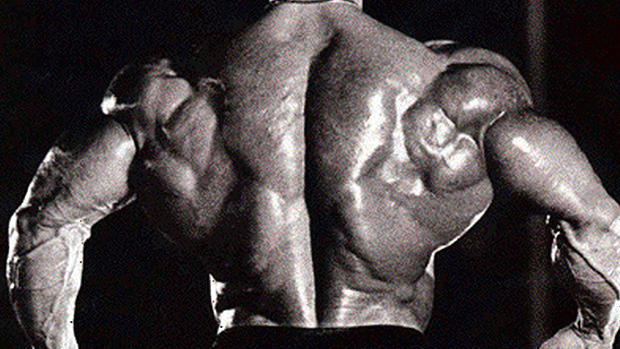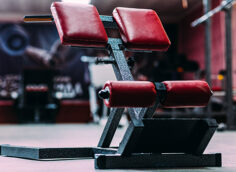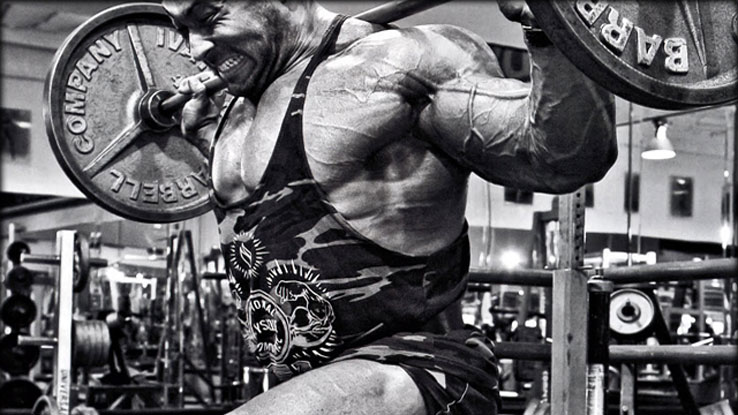If there's one truth in bodybuilding, it's that you'll never rise through
the amateur ranks if you don't have adequate back development. Have you ever
stopped to ponder what physical trait all Mr. Olympia winners have
in common (and think of the varied bodies that have won the Sandow trophy)?
You guessed it, Skippy, a great back.
 |
Dorian's Olympian back
A terrifically-built back isn't just wide, or just thick,
or just separated, or just detailed. It's all of these
things. And while eating correctly and implementing aerobic exercise can
help take care of the final attribute listed, the previous three characteristics
can only be achieved through brutal, consistent and well-constructed workouts.
The problem is, most trainers put little or no thought into how best to
work their back, and consequently don't achieve balanced and award-winning
development. It doesn't matter if you're into collecting shiny trophies or
not, either. If you train in a gym to build your body, you should build the
best body that you can build. Otherwise you're just wasting your time.
Fortress believes there are four fundamental directions a resistance must
be pulled or lifted regularly in order to build a kick-ass back. We'll call
this the Directional Back Training Principle. The four directions are:
1. Into the Body
2. Down From Overhead
3. Shoulders Up Towards the Ears
4. Low-Back Extension
It's annoying how few weight trainers these days actually care enough to
give their back the same beating they give their chest and arms. Pecs and
biceps are a dime a dozen. Tell me: are you proud of those little 14-inch "guns" with
the bulging veins, that you're always showing off in your little T-shirt
and tank top? Fortress is not impressed. Powerful legs and a strong
back make you a real athlete.
 |
Fortress is not impressed.
With the exception of your core, hips, and thighs, no other bodypart is
as essential to intense and explosive physical performance as your back.
Heck, it's the body's largest muscle complex: neglect it at your own peril.
You only need suffer one back injury to realize how it's involved in
almost all movements.
1. Into The Body
This movement is expressed in the gym using the common row-type exercises.
Bent barbell row, dumbbell row (one arm or two), T-bar row, machine row,
cable / pulley row, it's all good.
The point is to pull heavy resistance in such a way that your elbow joints
articulate as your upper arm gets almost perpendicular to the floor, regardless
of whether the tips of the elbows are flared out to the sides or pointing
in the opposite direction to which you're facing.
A mandatory ingredient in effective back training is the maintenance of
an arched (or at the very least, flat) back position when performing any
exercise. While this is good advice for weight training in general to help
prevent injury, it's fundamentally important when doing upper-back work
to ensure the proper muscles do the majority of the lifting. Your biceps
will be called too much into play with a rounded back.
 |
We'll give him a 9.5 for form, 3.5 for color sense.
Perhaps this explains why you get a wicked biceps pump when you train your
back. It's all too easy to allow the arch to disappear when you use too much
resistance for your strength levels (ego lifting) or arrive at the final,
and hardest, repetitions, and become fatigued.
One of the greatest tips that can be offered to a novice is to always use
considerably less weight on upper-back movements than what one has in mind.
It's amazing how drastic the improvement in back development can be when
young and inexperienced bodybuilders drop the weight and focus on correct
technique.
It's been said that back training is more difficult to
"feel" because we cannot see it during our sets and, thus, it is harder to
form a mind-muscle link. Not overdoing resistance can help to facilitate
better concentration. As well, we spend our entire lives seeing the fronts
of our bodies, so that reinforced visual of how various muscles look when
flexed aid us in determining proper lifting form.
Maybe Fortress' Directional Back Training Principle seems obvious. Maybe
you've never really considered such a thing. Either way, it's worth looking
into a little more thoroughly, wouldn't you say? (Just nod your head in the
affirmative and Fortress won't have to kill you.)
2. Down From Overhead
Or pulling yourself up. However you wanna think about it, Bucky.
Most bodybuilders who want that much-desired V-taper these days are just
plain lazy and opt to use a pulley system when they train their backs.
Performing chins with an overhand orunderhand grip is a tough job
for most, true. However, it's always worth the time to seek improvement
(more reps and sets). If you can already perform reps and sets, great; if
not, do your best for one or two sets at the start of your Down From Overhead
training. Remaining sets can be done with an overhead pulley. But I digress.
 |
Chins are more demanding than cable pulldowns, but the results are worth
it.
Don't spend too much time racking your brain over whether an overhand grip,
an underhand grip, or a neutral (palms facing each other) grip is best for
pulldown exercises. Instead, vary your grip from workout to workout.
For overhand, ensure that you're bringing the bar down to a point just in
front of and below your chin. As stated, maintain an arched back. Think of
it as keeping your chest as high as possible throughout the repetitions.
This action will ensure you are keeping the right posture.
When using an underhand grip, keep your hand spacing slightly narrower than
shoulder width, and keep the elbows tucked in tight to the sides of the body
as the resistance is pulled. Finish each rep at a point high on the chest.
This version of the pulldown can produce a unique feeling in the lower lats.
The neutral-grip handle, both narrow and wide versions, is a great, but
overlooked, piece of apparatus that can often allow the use of additional
weight. If your gym has one, make use of it. Your touch-point at the finish
of each rep is the same as on overhand-gripped pulldowns, just in front of
and below your chin.
3. Shoulders Up Towards the Ears
In other words, shrugging-type exercises. And again, there are multitudes
of ways to perform the shrug: with a barbell, dumbbells, machine apparatus,
or low-pulley attachment. Forget raising your shoulders and rolling them
forwards or backwards. All this achieves is to grind your shoulder joint.
Simple raise your shoulders as high as you can, pause very briefly, and then
return to the starting position.
 |
Asked why he has such a big gut, Ronnie simply shrugged.
A word of caution. Don't completely let your shoulders hang with zero tension.
Especially with very heavy weight, this can injure the joints. Fortress doesn't
know the data but has seen it happen a couple times.
Total volume seems to make a profound difference in building traps. Fortress
has always referred to the traps as "high redline"
muscles. This meaning they respond well to the maximal blood engorgement
that happens when lots of reps and sets are performed. Heavy weight, low
reps; light weight, high reps. Do it all. And lots.
4. Low-Back Extension
In Fortress-land, we achieve manly low-back extension with variations of
the deadlift movement. Bodybuilders of today, many who are living in Girly-man-land,
largely shy away from this exercise. Big mistake. This powerhouse exercise
can add a visual element to the physique that cannot be built any other way.
Forget the pussy back raise (otherwise known as the hyperextension). Are
you conditioning your low back, recovering from an injury, or trying to build
some fuckin' muscle?
 |
The Pussy Back Raise
I mean, c'mon. Cottage cheese-ass chicks wearing far too little clothing
in public do this movement. Fuck 'em and the horses they rode in on. As a
matter of fact, fuck you!
 |
...and the horse you rode in on.
Oops...sorry. Fortress just experienced a Testosterone surge. Happens from
time to time. Actually, it happens all the time. My apologies.
Obviously the deadlift in its purest expression (as done in powerlifting
competition, both with a conventional or Sumo style) is the greatest overall
version to build maximal muscle. The problem for bodybuilders, however, is
the involvement of the hams and thighs when doing the exercise in this "pure" manner.
Why is it undesirable to tax the hamstrings and quad muscles when training
the deadlift? Well, bodybuilders usually train groupings of bodyparts in
split-type programs. Because of this, the deadlift is very difficult to fit
into a regular routine without fatiguing and making sore these muscles the
day prior to a full-scale leg workout, or attempting deads on a day when
these muscles are already sore.
To get around this, many physique enthusiasts choose to modify the standard
deadlift in a way that lessens the involvement of the hams and quadriceps.
Simply shortening the stroke of the exercise by lifting the barbell from
a point just around the knees (in a rack) can make the difference.
 |
This physique enthusiast lifts the barbell from just around the knees.
So, too, can performing a stiff-legged deadlift, provided it's only your
thigh muscles you wish not to involve. Stiff-legged deadlifts will smash
your hamstrings fully. Some bodybuilders do stiff-legged deadlifts on their
leg day, which is a great idea. Before youdo this, the question you
should be asking yourself is, "Do I have the balls?"
 |
Well, do ya... punk?
Back to the Gym!
My Directional Back Training Principle, utilized consistently, will go a
long way to ensure your back becomes something for which you can be proud.
Not only will it look wide, balanced and thick, but it will also look functional,
because it is! And the development and functionality will help ensure
many years of injury-free training to afford you the opportunity to get those
14-inch "cannons" of yours bigger than your sister's.





